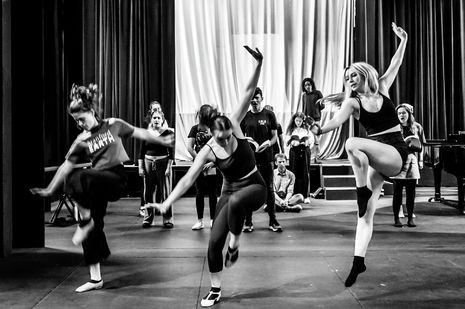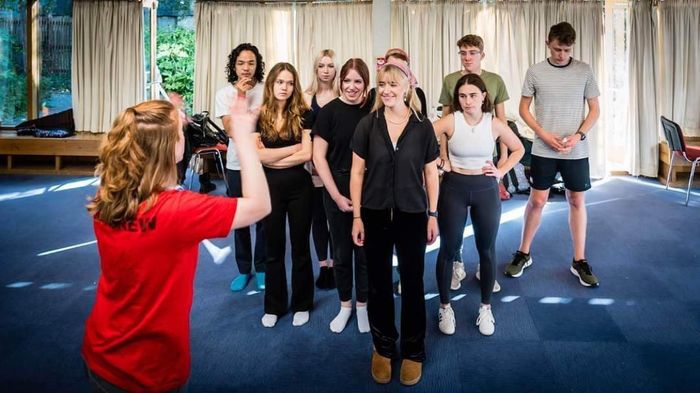5, 6, 7, wait, what happens when the fouettés fall?
In her second peek behind the curtain, Emily Sparkes looks at how choreographers overcome their challenges

Hearing Hannah, Gina, and Grace share their experiences with choreography was illuminating. But our conversations also revealed the various challenges they had all faced. I realised that to choreograph in the Cambridge theatre scene takes resilience, dedication, and genuine passion.
As a choreographer myself, something Hannah said about the process of teaching choreography really struck me. “Dance itself is a vulnerable experience ... so to say to a room of people: ‘I’ve come up with movements which I think are effective; this is what I’m asking you to do’ is a terrifying thing. Everyone’s then invited to judge it.” Unfortunately, the vulnerability choreographers show their collaborators isn’t always met with respect and an open mind.
All three shared stories of teaching choreography and being met with disinterest, a lack of effort, or direct rudeness. This can be a frustrating experience when they’ve spent hours deliberating counts and steps with the abilities of the cast in mind; they all shared that it felt like there was a level of respect they wished for that wasn’t always being met. For example, Hannah has had a rehearsal interrupted by a cast member declaring: “this choreography is shit, and I hate it”. Moments like this leave choreographers in difficult positions: trying to juggle maintaining leadership of the room, fulfilling both their and the director’s vision, and also respecting the cast’s own comfort performing the routine on stage.
“A little bit of effort from those being taught can go a very long way”
It would, however, be unfair to say that these attitudes stem from malicious intent. Hannah, Gina, and Grace all recognised that often what is presenting itself as rudeness is actually an unease at being pushed out of one’s comfort zone. When met with a refusal, Gina says she’ll “take a deep breath, choreograph something new on the spot” (which is not as easy as it sounds) and try to “not let it impact the atmosphere of the rehearsal”. Grace explained how, often, the more challenging rehearsals happen early in the process; choreographers completely understand that their routines will take time to perfect, but that can’t be done if cast members simply refuse to learn choreography. Teaching and learning to dance are both vulnerable experiences, so remembering that the person in front of you is, in fact, another human being with their own emotions and experiences seems crucial. And though student theatre is often impacted by degree - or life -related anxiety and stress, a little bit of effort from those being taught can go a very long way.
Having grown up in the dance world, Hannah described the “history of toxicity” she knows dominates a lot of people’s experiences with dance, and Grace recognised how the stressful atmospheres created growing up in competitive dance has the potential to transfer into casts and rehearsals. All three, therefore, make conscious efforts to foster positive atmospheres in their rehearsal rooms so they can be viewed as safe spaces. Hannah has researched physical anatomy to help dancers understand their muscular injuries and the impact on their dancing, Grace looks out for performers’ comfort when choreographing intimate moments, and Gina sensitively distinguishes between the way she teaches in musical theatre rehearsals as compared to dance classes. I have inherited this practice of care – for example, whenever I lead rehearsals, I run optional welfare check-ins before starting a physical warm-up and check in with the cast while I’m teaching to make sure everyone’s happy with both difficulty levels and the pace I’m teaching at. By doing things like this, we’re all trying to break away from the damaging dance cultures we grew up in to encourage a healthy love for dance.
“Another challenge is the startling lack of communication between choreographers and the production team”
Another challenge presents itself in the startling lack of communication between choreographers and the production team. Gina feels: “choreographers should absolutely be in the core production team meetings about things like costume, lighting, and set design.” Often, last-minute issues arise close to opening night in technical and dress rehearsals (like actors unable to do floorwork in skirts, or half of the ensemble not being lit). If the choreographer had been at the relevant meetings, these issues – which frequently result in choreography being cut – might have easily been solved.
Another way this lack of communication manifests is when directors seem afraid of tackling choreography. Choreographers have no expectations of a director’s knowledge of dance, and don’t expect them to communicate ideas using technical terms, but saying to a choreographer: “you have complete free range”, can become problematic. A director could later feel their vision has been lost, or simply that the choreography “doesn’t work”, but without key communication from a director of what they want (even if it’s in the form of YouTube videos, “vibes”, or mood boards) choreographers are often placed in difficult, if not impossible, situations.
As Grace saliently notes: “choreographers are only human!” They will have rehearsals where they forget their planned choreography, or they’ll try to challenge a cast with what they’re teaching. But as people, your choreographers are giving up many more hours of their time than you might realise with the sole intention of making sure you look good on stage, and there is a level of respect they deserve to always be given.
I’ll close with Hannah’s insight: a happy and productive process “takes respect; a choreographer respecting their cast and the work that they put in, showing the cast the respect they want to be shown themselves. It takes more than a choreographer to create a positive environment.”
 News / Caius mourns its tree-mendous loss23 December 2025
News / Caius mourns its tree-mendous loss23 December 2025 News / Clare Hall spent over £500k opposing busway 24 December 2025
News / Clare Hall spent over £500k opposing busway 24 December 2025 Comment / The ‘class’ of Cambridge24 December 2025
Comment / The ‘class’ of Cambridge24 December 2025 Comment / Yes, I’m brown – but I have more important things to say22 December 2025
Comment / Yes, I’m brown – but I have more important things to say22 December 2025 Interviews / Politics, your own way: Tilly Middlehurst on speaking out21 December 2025
Interviews / Politics, your own way: Tilly Middlehurst on speaking out21 December 2025








